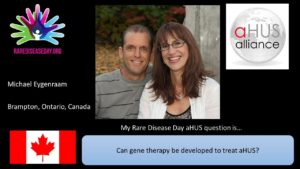There is another very good question from Hyde Talbot of Cumming Georgia in the video ( click here to view video).
” When will there be a cure?”
Some times the terms cure and treatment are interchanged but they do not mean the same thing.
Some diseases can be cured, but others like aHUS have no cure as yet; but now have treatments which help manage the disease.
aHUS is the result of uncontrolled activation of a part of the immune system known as Complement. All aHUS patients share the same damaging effects of clotting and destruction of red blood cells in the vessels carrying their blood , particularly the very small vessels known as capilliaries. For aHUS patients the capilliaries in the kidneys are a specific problem and aHUS causes them not to work.
So aHUS patients have symptoms of anaemia ( extreme tiredness) and fluid build up as an outcome of the kidneys not working.
Medical professionals use medication, therapy, surgery, and other treatments to help lessen the symptoms and effects of a disease.
For aHUS that would mean replacing red blood cells with blood transfusions to lessen effects of the anaemia and to get more oxygen to the body; and dialysis, which just an artificial kidney and a way of getting rid of fluid and toxins from the body. This deals with the most serious and life threatening symptoms.
The patients still has aHUS and it continues, so something needs to done to stop the patients uncontrolled immune system. A way was found by exchanging the patient’s plasma , the part of the blood with the defective complement control component , for new plasma, which contains an effective complement control component. That can stop aHUS.
But the part of the body that produces the ineffective complement component continues to do so , for example, ineffective complement component Factor H is produced in the liver and that production will not have altered. So the good plasma will ,over time , be replaced by the patients defective complement and the aHUS cycle continues. It is a treatment but not a cure.
Having continuous plasma exchange to control aHUS is a burden , particularly, when frequently done in conjunction with dialysis and still the aHUS is not cured. But for some it is enough, or all there is .
However research came up with a way of stopping the damaging effect of the immune system in the case of aHUS i.e. eculizumab. .
Eculizumab helps controls an aHUS patients uncontrolled complement , it stops it altogether by attaching to a specific component ( that in itself is not actually defective ) and prevent it doing more damage. Coversin is another complement inhibitor in development/trial which works in a similar way.
Another way of doing the same thing is by stopping the production of that component so it is not there to do a job. There is a drug in development/trial ALN CC5 which does just that . ( There are lots of developments going on for more information about them in an alliance briefing use this link)
Either way with the damaging effect stopped it means that the aHUS patients symptoms begin to disappear and other treatments may not longer be needed. “May not” because sometimes the amount of damage to the kidney means the aHUS patient will need to continue with kidney dialysis. Kidney failure is something else that is uncurable
Eculizumab is still not a cure as the patients own complement control component remain defective, and the fault in the part of the body producing it remains. The organ that is producing the faulty component could be replaced is e.g the liver is also replaced which leads to other risks; and other than producing defective complement component the aHUS patients is usually OK.
Until a way is found to change the way the faulty component is made by the patients own body then the aHUS patient remains uncured.

Michael Eyegenraam of Brampton Ontario Canada’s question is ” Can gene therapy be developed to treat aHUS”
For that to happen there needs to be an introduction of normal genes into cells in place of defective ones in order to correct genetic disorders. This is known as gene therapy.
In some cases existing gene cells are removed and donor stem cells grow and replace them . In other cases new donor stem cells are infused so that they grow and take over from existing gene cells. Both have to be done in a way to avoid rejection.
Diane of Orange California also asks whether it looks promising that gene editing will be an option for her daughter in the future? In this gene therapy DNA is inserted ,deleted or replaced in the persons genome (maybe even before birth) to alter the acquired DNA from parents.
The alliance is not aware of examples of either taking place for aHUS today; but there may well be research going on into the possibility.
The good news is that researchers are constantly coming up with advances in medicine. So it’s possible that a disease that can be treated but not cured today may be cured in the future. How long will that be? Successful stem cell therapies have been developed in the past ten years to cure other diseases, so who knows what another 10 years might bring for a cure for aHUS
In the mean time the other good news for some aHUS patients is that once the first episode is brought under control and the embers of aHUS extinguished, the patient may not experience it again and the disease will remain in remission. But just why that might be so is another question?



